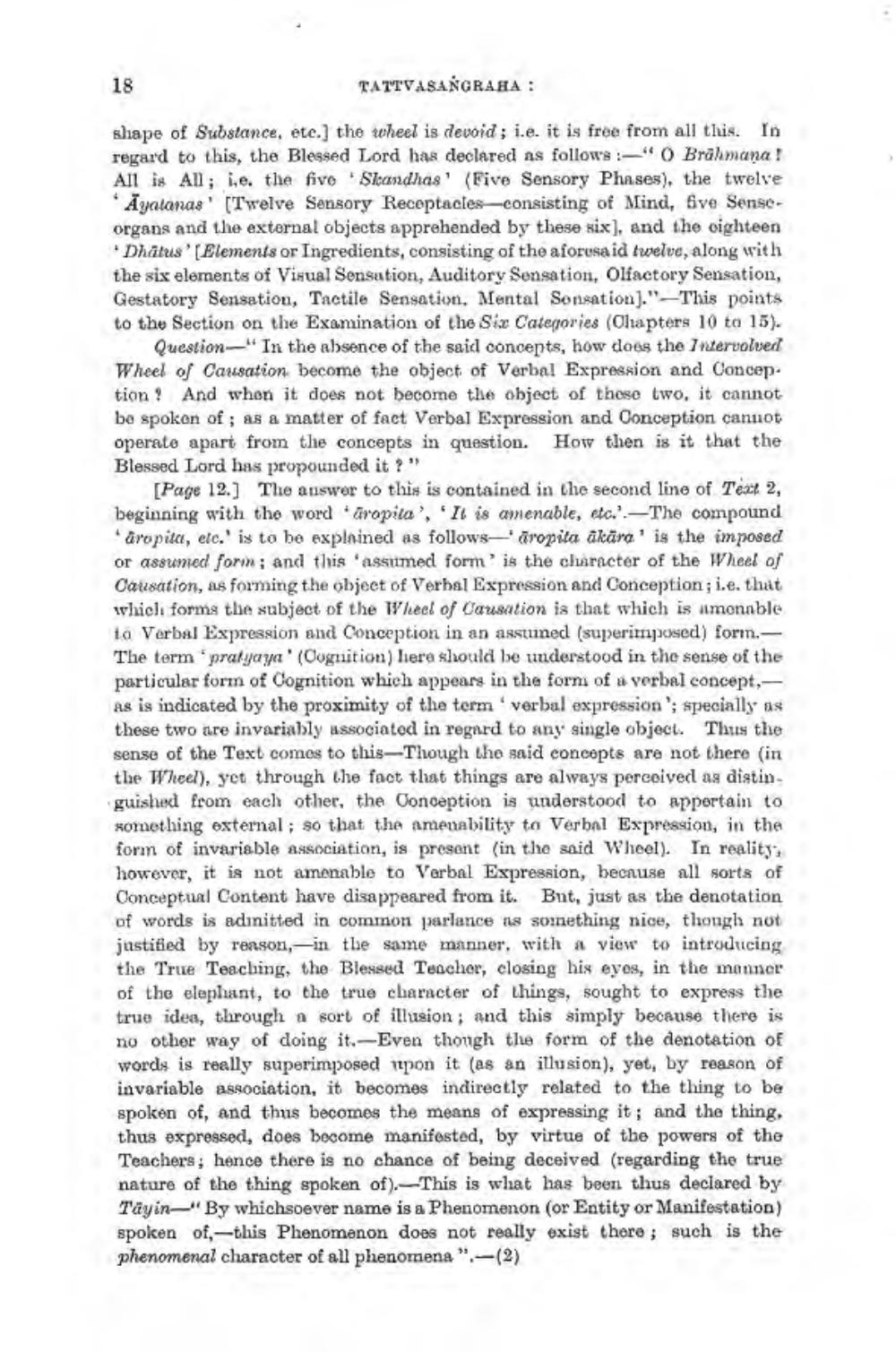________________
18
TATTVASANGRAHA :
shape of Substance, etc.) the wheel is devoid ; i.e. it is free from all this. In regard to this, the Blessed Lord has declared as follows :-"O Brahmana! All is All; le. the five Skandhas' (Five Sensory Phases), the twelve * Ayalanas' (Twelve Sensory Receptacles-consisting of Mind, five Senseorgans and the external objects apprehended by these six), and the oighteen
Dhatus '[Elements or Ingredients, consisting of the aforesaid twelve, along with the six elements of Visual Sensation, Auditory Sensation, Olfactory Sensation, Gestatory Sensation, Tactile Sensation, Mental Sonsation)."--This points to the Section on the Examination of the Six Categories (Chapters 10 to 15).
Question-"In the absence of the said concepts, how does the Intervolved Wheel of Causation become the object of Verbal Expression and Conception? And when it does not become the object of these two, it cannot be spoken of; as a matter of fact Verbal Expression and Conception cannot operate apart from the concepts in question. How then is it that the Blessed Lord has propounded it?"
[Page 12.] The answer to this is contained in the second line of Text 2, beginning with the word "dropita', 'It is amenable, etc.'.—The compound
aropitci, etc.' is to be explained as follows— aropita äkāra' is the imposed or assumed form; and this 'assumed form is the character of the Wheel of Catzsation, as forming the object of Verbal Expression and Conception; i.e. that whicle forms the subject of the Wheel of Causation is that which is amonable ia Verbal Expression and Conception in an assumed (superimposed) form.The term "pratyaya' (Cognition) here should be understood in the sense of the particular form of Cognition which appears in the form of a verbal concept,As is indicated by the proximity of the term 'verbal expression '; specially as these two are invariably associated in regard to any single object. Thus the sense of the Text comes to this-Though the said concepts are not there (in tle Wheel), yet through the fact that things are always perceived as distinguished from each other, the Conception is understood to apportain to something external ; so that the amenability to Verbal Expression, in the form of invariable association, is present in the said Wheel). In reality. however, it is not amenable to Verbal Expression, because all sorts of Conceptual Content have disappeared from it. But, just as the denotation of words is adınitted in common parlance is something nice, though not justified by reason, in the same manner, with a view to introducing the True Teaching, the Blessed Teacher, closing his eyes, in the manner of the elephant, to the true character of things, sought to express the true idea, through a sort of illusion; and this simply because there is no other way of doing it.-Even though the form of the denotation of words is really superimposed upon it (as an illusion), yet, by reason of invariable association, it becomes indirectly related to the thing to be spoken of, and thus becomes the means of expressing it; and the thing, thus expressed, does become manifested, by virtue of the powers of the Teachers; hence there is no chance of being deceived (regarding the true nature of the thing spoken of). This is what has been thus declared by Tayin-By whichsoever name is a Phenomenon (or Entity or Manifestation) spoken of, -this Phenomenon does not really exist there ; such is the phenomenal character of all phenomena",-(2)




